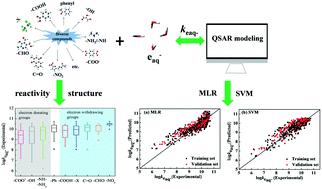当前位置:
X-MOL 学术
›
Environ. Sci.: Water Res. Technol.
›
论文详情
Our official English website, www.x-mol.net, welcomes your feedback! (Note: you will need to create a separate account there.)
QSAR modeling for reaction rate constants of eaq− with diverse organic compounds in water
Environmental Science: Water Research & Technology ( IF 5 ) Pub Date : 2020-06-01 , DOI: 10.1039/d0ew00244e Shanshan Zheng 1, 2, 3, 4, 5 , Chao Li 5, 6, 7, 8 , Gaoliang Wei 1, 2, 3, 4, 5
Environmental Science: Water Research & Technology ( IF 5 ) Pub Date : 2020-06-01 , DOI: 10.1039/d0ew00244e Shanshan Zheng 1, 2, 3, 4, 5 , Chao Li 5, 6, 7, 8 , Gaoliang Wei 1, 2, 3, 4, 5
Affiliation

|
The hydrated electron (eaq−)-based advanced reduction processes (ARPs) are recognized as a reliable and feasible approach for decontamination of water pollutants. The reaction rate constant (keaq−) of eaq− with organic pollutants is a crucial parameter for assessing their removal efficacy and designing the ARPs. In this work, quantitative structure–activity relationship (QSAR) models for predicting the keaq− values of structurally diverse compounds were developed using both multiple linear regression (MLR) and support vector machine (SVM) methods. The developed models covered a larger dataset (>600 compounds) and exhibited wider applicability domains than existing models, as well as possessing adequate goodness-of-fit (MLR: Rtr2 = 0.712; SVM: Rtr2 = 0.805) and predictability (MLR: Rext2 = 0.816, Qext2 = 0.724; SVM: Rext2 = 0.830, Qext2 = 0.769). Mechanistic analysis revealed that the reactivity of compounds towards eaq− was highly related to energy of the lowest unoccupied molecular orbital (ELUMO), percentage of halogen atoms (X%), the most negative charge on Br atom (qmin,Br) and hardness (η). Additionally, the functional group analysis indicated that the compounds with electron withdrawing groups tended to have increased reactivity towards eaq− compared to those with electron donating groups. The developed QSAR models may serve as a valuable strategy for assessing the removal efficiency and understanding the fate of various pollutants in eaq−-based ARPs.
中文翻译:

QSAR建模,用于eaq−与水中多种有机化合物的反应速率常数
水合电子(E水溶液- )基先进还原过程(的ARP)被认为是水污染物的净化的可靠和可行的方法。反应速率常数(ķ Ë水溶液-的E)水溶液-有机污染物是评估它们的去除效果和设计的ARP的关键参数。在这项工作中,定量构效关系(QSAR)模型预测ķ ë含水-使用多元线性回归(MLR)和支持向量机(SVM)方法开发了结构多样的化合物的分子式。与现有模型相比,已开发的模型涵盖了更大的数据集(> 600种化合物),并且显示了更广泛的适用范围,并且具有足够的拟合优度(MLR:R tr 2 = 0.712; SVM:R tr 2 = 0.805)和可预测性(MLR:R ext 2= 0.816,Q ext 2= 0.724; SVM:R ext 2= 0.830,Q ext 2= 0.769)。机理分析表明,化合物对水溶液的反应性-与最低未占据分子轨道的能量( E LUMO),卤素原子的百分比( X%),Br原子上的最大负电荷( q min,Br)和硬度( η)高度相关。另外,该官能团分析表明,具有吸电子基团的化合物往往具有增加的反应性向ë水溶液-与那些比较与供电子基团。在发达的QSAR模型可以作为评估的去除效率和理解各种污染物的命运在电子商务的宝贵战略水性-基的ARP。
更新日期:2020-07-02
中文翻译:

QSAR建模,用于eaq−与水中多种有机化合物的反应速率常数
水合电子(E水溶液- )基先进还原过程(的ARP)被认为是水污染物的净化的可靠和可行的方法。反应速率常数(ķ Ë水溶液-的E)水溶液-有机污染物是评估它们的去除效果和设计的ARP的关键参数。在这项工作中,定量构效关系(QSAR)模型预测ķ ë含水-使用多元线性回归(MLR)和支持向量机(SVM)方法开发了结构多样的化合物的分子式。与现有模型相比,已开发的模型涵盖了更大的数据集(> 600种化合物),并且显示了更广泛的适用范围,并且具有足够的拟合优度(MLR:R tr 2 = 0.712; SVM:R tr 2 = 0.805)和可预测性(MLR:R ext 2= 0.816,Q ext 2= 0.724; SVM:R ext 2= 0.830,Q ext 2= 0.769)。机理分析表明,化合物对水溶液的反应性-与最低未占据分子轨道的能量( E LUMO),卤素原子的百分比( X%),Br原子上的最大负电荷( q min,Br)和硬度( η)高度相关。另外,该官能团分析表明,具有吸电子基团的化合物往往具有增加的反应性向ë水溶液-与那些比较与供电子基团。在发达的QSAR模型可以作为评估的去除效率和理解各种污染物的命运在电子商务的宝贵战略水性-基的ARP。



























 京公网安备 11010802027423号
京公网安备 11010802027423号